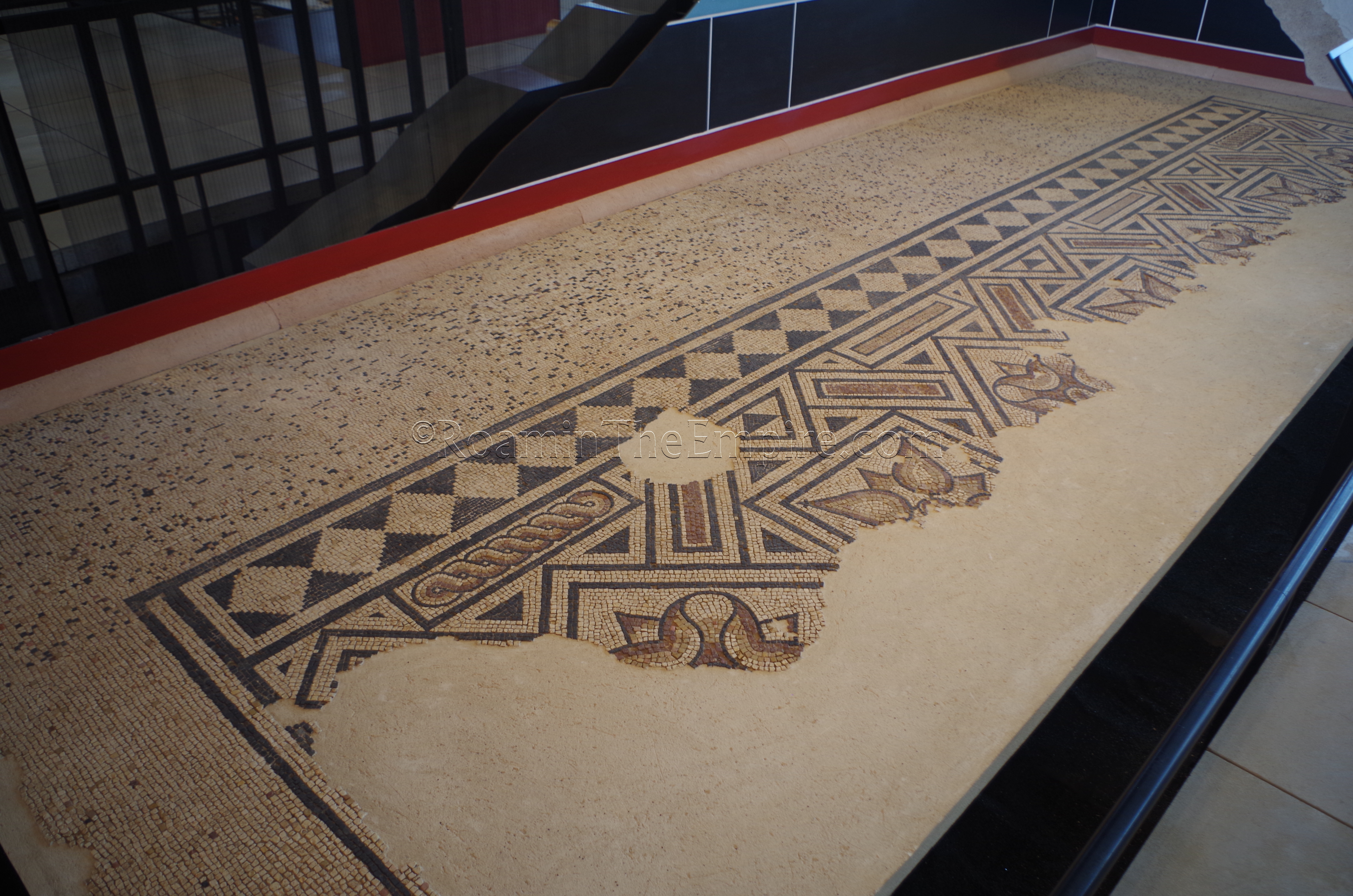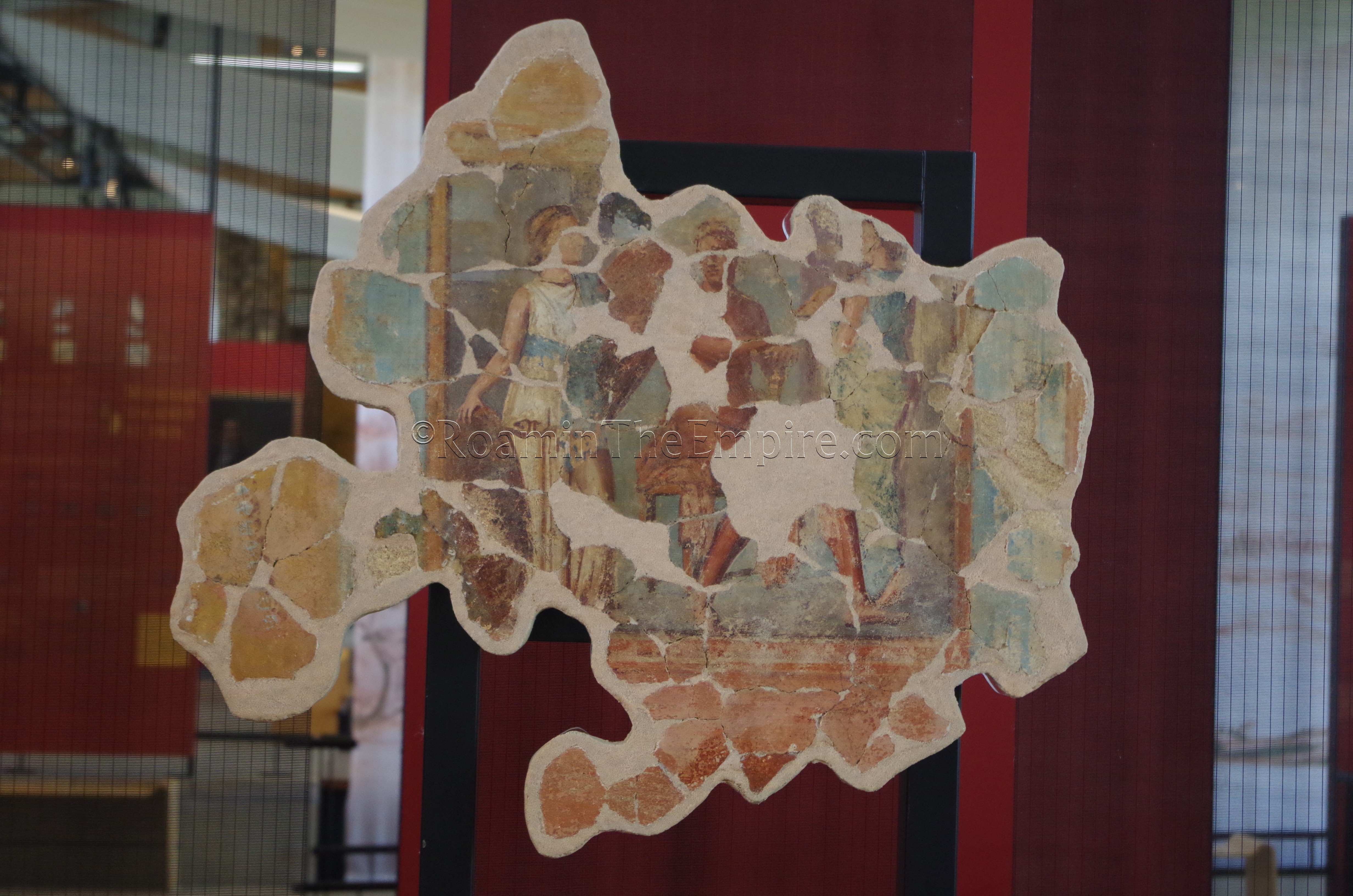
Most Recent Visit: June 2018.
About 10 kilometers to the southwest of the modern city of Caen is the town of Vieux, the location at which the ancient town of Aregenua once stood. While the location of Aregenua fell within the area inhabited by the Viducasse prior to the arrival of the Romans, there does not seem to have been any sort of significant settlement during the Gallic period. During the Augustan administrative reforms of Gaul, the Viducasse were given an administrative area, and it seems that at this time, construction began on Aregenua as the chief city of this administrative region, which was one of the smallest such regions in Gaul. Aregenua appears on the Tabula Peutingeriana with the designation as a principal city. The first securely datable phase of the building program for Aregenua seems to come about the time of Claudius
The town seems to have flourished through the end of the 1st and into the 2nd centuries CE. At the height of the town’s prosperity, it is believed to have had a population of between 4,000 and 6,000 residents with a size of about 40 hectares. Though monumental construction seems to have continued into the 3rd century CE, it was at this point that the Aregenua appears to have entered into a period of decline. The turmoil caused by the conflict for succession and subsequent revolt of Clodius Albinus in Gaul at the end of the 2nd century CE probably had some impact on precipitating this decline. The decline continued through the 3rd and 4th centuries CE (though there was apparently a brief period of renewal during the 4th century CE) and at some point in that time, Aregenua lost its status as a capital city, and the duties were transferred to Augustodurum (modern Bayeux). A Saxon raid in the 3rd century CE may also have hastened the demise of the already declining town. No longer the chief settlement in the small region of the Viducasse, the town eventually devolved into a largely rural area, with no significant settlement at the site between at least the 5th to 7th centuries CE.
Getting There: There is bus line that runs between Caen and Vieux, though it obviously caters to commuters, as there are more frequent morning buses going in the direction of Caen, and more buses going in the direction of Vieux in the afternoon. Even then, the schedule of stops in Vieux is rather infrequent. The line is run through Bus Verts and is designated as Line 11. The schedules can be found here. The price for the trip is 2.50 Euro each way. The website for the Vaison-la-Romaine museum also notes that there is an ‘on-demand’ bus service offered by Bus Verts as well, though the price is likely much more significant than the established line and reservations must be made the day before travel. I had a rental car for my trip, and with that, Vieux is easily reachable from Caen. There is a large parking lot near the museum, and everything else in the town is within walking distance of the museum.

Fairly significant remains of Aregenua have been found at Vieux; the Roman layers are apparently only 20-40 centimeters below the modern surface point. Unfortunately, however, a good portion of those remains, excavated in previous centuries, are no longer visible. Just to the west of the parking lot for the Musée Vieux-la-Romaine, for instance, were the well-attested remains of the amphitheater, which are no longer visible in any capacity.
The best place to start is at the Musée Vieux-la-Romaine. Aside from having a convenient parking lot, the museum helps contextualize the rest of the remains somewhat, and the rest of the remains in town are signed from the museum. The museum is located at 13 Le Chemin Hausse, but the parking lot is accessed off the D89 just before entering town from the north. The museum is open on Monday, Tuesday, Thursday, and Friday from 9:00 to 17:00, and on Saturday and Sunday from 10:00 to 18:00. It is typically closed on Wednesdays, except during school holidays, during which it is open regular weekday hours. Admission to the museum is 5 Euros.

On the grounds of the museum, between the parking lot and the museum, are the remains of a small 3rd century CE Gallo-Roman domestic structure, called the ‘U House’. Most of what remains here are very low foundations of the building, though there is an impluvium-like cistern structure in the courtyard/atrium of the house. Adjacent to the house, a stretch of the decumanus and crepido are preserved running along the south side of the structure. There were apparently the remains of other structures, including shops and a sanctuary, found on the grounds of the museum, but nothing other than the house and its immediate surroundings is visible. There are a few reconstructed Celtic displays outside the museum as well.

The museum itself is not very big, but it is very modern and open. It boasts few larger pieces; there is no mostly complete statuary or large inscriptions, but there are a number of smaller pieces. I might, in fact, categorize the museum as one that suffers a bit from the problem of having a large amount of the small day to day objects and attempting to display them all in a somewhat crowded manner. The openness of the museum and the use of natural lighting also impacts this, as most objects are in glass cases that are obscured by glare from nearly every side. It is not, of course, as drastic as it shows up in with photos, but, it’s still there and a bit distracting, particularly when items are already heaped in display cases.

There were a few very interesting pieces to the museum, though, particularly from the nearby House of the Grand Peristyle. Some decorated pillars from the remains from the peristyle of the house are reconstructed and displayed near the front of the museum. There’s also a few fragments of wall painting, one in particular depicting a scene from the Iliad; Thetis giving arms to Achilles while Briseis watches nearby. A large fragment of mosaic pavement from one of the rooms of the house also features in the collection. There are some interesting items from among the smaller finds, but again, it’s easy for them to get lost in the fold.
The main part of the museum took me about a half an hour to get through. There was an additional temporary exhibit that took another few minutes to see. Most of the signage in the museum is in French only; there are a few informational cards with short synopses in English, but, these are few and far between. The price seems a little expensive for the actual museum in comparison to others, but taking into account that the other currently viewable site in town is free access and the museum admission goes toward maintaining that as well, it’s a bit more reasonable.

A few minutes’ walk away from the museum, to the south, are the other visible remains from the city, signposted with directions from the museum. On the west side of the road, Les Crêtes, are the covered remains of the forum. While they are advertised on the website, they are not open for visit, aside from reserved guided tours, or daily tours in July and August, apparently. When I visited, there really didn’t seem to be any sign of recent activity, and the people at the museum did not seem to have any knowledge of an ability to visit the remains of the forum. The excavations here are presently ongoing, evidently part of why only guided tours are allowed, rather than open access.

On the east side of the road are the remains of La Maison au Grand Peristyle, the House of the Grand Peristyle, so named because of the large peristyle central to the remains of the dwelling. The spot of the house originally served as an artisan production area when originally constructed in the 1st century CE. Over the course of the last three quarters of the 1st century CE, though, the building evolved into an increasingly more complex and luxurious domestic building. It continued to undergo less drastic changes into the 3rd century CE, and what is currently excavated and on display reflects the state of the building at that time. By the 4th century CE, however, the house had suffered a series of fires, perhaps corresponding to Germanic raids in the area, and eventually fell into disrepair and was abandoned and spoliated around that time.

Again, there is no admission to this archaeological area, though there are gates that can be closed to prevent access. While hours are not explicitly stated for access to the house, it is probably safe to assume they coincide with the hours of the museum. Even when access is restricted, there is an overlook a little ways down the street, so the remains can be viewed, from a distance, at all times. The remains of the house are incomplete, as there are sections that are missing architecture, but there are a pretty significant number of intact rooms. The reconstruction is readily apparent to those familiar with such things, but, it isn’t overdone. There are a few mosaics conserved in-situ, as well as a cross section of a reconstruction of the hypocaust system of one of the rooms (not part of the bathing area).

There are a few areas of particular interest in the house, though many of the rooms are largely indistinguishable through anything other than labels; the bathing complex area, for instance, doesn’t really look any different than any other room. There are small descriptions, in French, for the rooms and areas of the house. A sign posted at the entrance to the area has signs with English translations, but the signs at the overlook area have no English translations. Since there aren’t many details, it only took about 20 minutes to walk around the house and see everything; even if your French is fluent and you can read the posted signs, I wouldn’t add more than a few minutes extra to that time.

There is apparently also a part of a building remaining to the northwest of the forum and house, but it is on private property and not visible. All in all, the museum and remains of Aregenua took just a little over an hour, so it’s not a very intensive stop, but is well worth it because of that. It’s something that can easily fit into any itinerary in the area without devoting a huge amount of time; particularly if not having to rely on public transportation. In that case, it might not be worth the effort for most people, as the amount of time and effort spent getting to the site might outweigh what remains here to be seen.
Sources:
Museum and site signage.
Coulthard, Nicola. “The Question of Site Enhancement in Rural Contexts: Examples of Projects Managed by the Calvados Departmental Council (Conseil Général Du Calvados), Lower Normandy.” Castles and the Anglo-Norman World, Oxbow Books, 2016.
Delaval, Éric. “Vieux, Antique Aregenua: Acualité de la Recherche.” Revue Archéologique, Vol. 1, 2006, pp. 215-220.
Jardel, Karine, et al. “Le forum et la curie d’Aregenua (Vieux, Calvados): Bilan sur les découvertes anciennes et les recherches récentes.” Gallia, Vol. 71, No. 2, 2014, pp. 163-188.
Stillwell, Richard, William L. MacDonald, and Marian Holland. McAllister. The Princeton Encyclopedia of Classical Sites. Princeton, NJ: Princeton U Press, 1976.
Vipard, Pascal “Un exemple d’échec urbain en Gaule Lyonnaise : Aregenua, chef-lieu des Viducasses (Vieux, Calvados).” Les Villes Normandes au Moyen Âge, Presses Universitaires de Caen, 2006.


